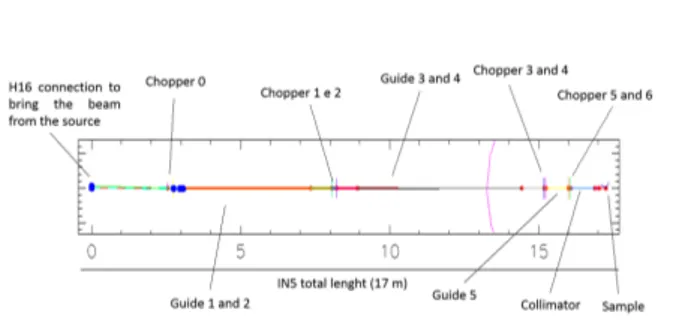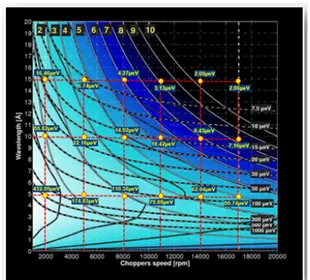Activity Report 2015 - Dottorato di Ricerca in Fisica, Universit`a di Messina
Monte Carlo Simulations of a RENS Operating ToF Neutron
Spectrometer
A. Cannuli
1, M.T. Caccamo
1, S.Magaz´
u
11Dipartimento di Scienze Matematiche e Informatiche, Scienze Fisiche e Scienze della Terra, viale F. Stagno d’Alcontres
31, Messina, Italy E-mail: [email protected]
Abstract
In the present work the results of simulations performed by means of the McStas Monte Carlo simulator software package are presented. In particular simulation results obtained with modified instrumental parameters, i.e. energy resolution and wave-vector range, through McStas interface allowed to evaluate the IN5 instrument behavior when operating following the RENS protocol.
Keywords: Resolution Elastic Neutron Scattering (RENS), McStas MonteCarlo simulations, European Spallation Source (ESS).
Introduction
The aim of this work is to simulate the Resolution Elastic Neutron Scattering (RENS) approach [1]-[2], which is based on the acquisition of the measured elastic scattering law as a function of the instrumen-tal energy resolution, for the IN5 instrument, a gen-eral purpose direct geometry Time of Flight (ToF) spectrometer of the Institut Laue- Langevin (ILL) of Grenoble, France. In the RENS approach the measured elastic scattering law as a function of the logarithm of the instrumental energy resolution be-haves like an increasing sigmoid curve whose inflec-tion point occurs when this instrumental resoluinflec-tion time matches the system relaxation time. Simula-tion results performed by means of the McStas Monte Carlo simulator software package to obtain the be-havior of the IN5 instrument operating following the RENS protocol are presented. At first, a brief de-scription of IN5 instrument is dealt; then, the sim-ulations performed assuming a wavelength of 5, 10 and 15 ˚A at different speeds of rotation of the chop-per respectively: 2000, 5000, 8000, 11000, 14000 and 17000 rpm. In particular, the first simulation with dynamical structure factor for Vanadium, obtained by keeping constant the thickness of the sample 1 mm and the incoming wavelength spread ∆λ 3 ˚A, the wavelength of 5 ˚A and the chopper speed of 11000 rpm, is reported. The final result of all simulations is the IN5 two-dimensional wavelength-choppers speed plane that confirm the validity of the RENS approach which is based on the acquisition of the measured
elastic scattering as a function of the instrumental energy resolution.
Methods: McStas software
package and IN5 spectrometer
McStas is a Monte Carlo simulation software, pro-grammed in C and assisted by Phyton-code for the interface (Graphic User Interface (GUI)). Born from the collaboration between DTU Physics (RISO DTU and RISO Natnl. Lab), University of Copen-hagen, Paul Scherrer Institute and ILL (Institut Laue-Langevin) in October 10, 2001; the current ver-sion is 2.1, released on 12-09-2014. The Monte Carlo method is used for the management of neutron in-teraction: the system generates a random number which is compared with a probability and, depending on the number extract, the particle assumes a given behavior [3]-[4]. It possible visualize 3D graphic of the desired simulated instrument. It allows to simu-late what happens changing of parameters (e.g. ge-ometry, chopper velocity, etc) and to evaluate the best conditions of use for existing instruments and to design new spectrometers. The present version supports both continuous and pulsed source instru-ments, and includes a library of standard components with in total around 130 components. IN5 is a gen-eral purpose direct geometry Time of Flight (ToF) spectrometer. It is used to study low-energy trans-fer processes as a function of momentum transtrans-fer. Typically this instrument is used for measurements
Activity Report 2015 - Dottorato di Ricerca in Fisica, Universit`a di Messina
in the small energy and momentum transfer region with values of the order of δE/E =1
Figure 1: 3D simulation of IN5 instrument Primary spectrometer: the chopper system pro-vides an extremely well defined resolution func-tion which remains nearly Gaussian (counter-rotating disks) down to 1/10.000 of its height. Secondary spectrometer: it consists in a large cylindrical ar-ray of pixelated position sensitive detector (PSD) mounted inside a vacuum time-of-flight chamber 4m from the sample. PSDs cover a large gapless detec-tion surface (30m2) with a spatial resolution
com-parable to triple-axis instruments. With the new detector, the instrument has a large solid-angle for powder and amorphous systems experiments and is fully equipped for single-crystal spectroscopy. Sam-ple area: A large samSam-ple chamber (max diameter = 80cm, depth∼ 130cm) allows hosting the broad range of IN5 sample environments but also user-designed equipment (contact instrument responsible before). The non-magnetic material surrounding the sample allows the use of either high magnetic field (limited to 2.5T at the moment it is foreseen to purchase a spe-cific magnet for higher fields - equal or above 10T) or neutron polarization devices (still to come).
Figure 2: 2D simulation of IN5 instrument IN5 is constituted by a series of guides, chopper and collimators, which accompany the neutron beam from the source to the sample. The neutrons diffuse along a series of optical guides, which avoids the dis-persion of the beam, their path is 17 meters. The chopper are 7: the chopper 0, 1, 2, 4, 5 and 6 all rotate at the same speed, the 3 has a speed propor-tional to that of the other chopper, usually half and this allows us to increase the interval between one
pulse and another. The chopper 0, 1, and 2 have an opening angle of 9◦, on 3 and 4 to 9.5◦, 5 and 6 have
angular aperture of 3.25◦. A small opening has the
purpose of monochromate the neutron beam. The guides have a total length of about 15 meters and are intended to focus the beam, thus to prevent the dispersion. The collimator has the purpose of making the neutron beam parallel, we IN5 of about 1 meter of collimator placed before the sample.
McStas IN5 experimental
results
We have performed the following simulations where some parameters were kept constant whereas r rota-tion speed within the limits of operarota-tion. Such limit parameters are reported in Table IN5 of the preced-ing paragraph. The simulations were performed as-suming a wavelength of 5, 10 and 15 ˚A at different speeds of rotation of the chopper respectively: 2000, 5000, 8000, 11000, 14000 and 17000 rpm. More pre-cisely in the first simulation the instrument parame-ters are: i) the thickness of the sample; having chosen a cylindrical can, taking into account both the sides of cylinder, the total thickness was 1 mm; ii) the incoming wavelength spread ∆λ, which was kept to the value of 3 ˚A; iii) the simulation was performed assuming a wavelength of 5 ˚A; iv) the chopper speed is 11000rpm. The chosen set-up parameter values of such a simulation are reported in Figure 3.
Figure 3: The table synthesizes the employed fitting parameters of the performed simulation. In particu-lar, the constant instrument parameters are: i) the thickness of the sample: 1 mm; ii) the incoming wavelength spread ∆λ: 3 ˚A.
The obtained output of the performed simulation results a Gaussian like curve whose width has been extracted through a fitting procedure obtained by means of the commercially available software ORI-GIN 9.0. The obtained Full Width at Half Maxi-mum (FWHM) is: ∆E 79.89µeV. In the following picture the obtained result is reported withing the two-dimensional plot wavelength-choppers speed. As it can be seen the agreement is very satisfactionable.
Activity Report 2015 - Dottorato di Ricerca in Fisica, Universit`a di Messina
Figure 4: Simulated dynamical structure factor for Vanadium as obtained by keeping constant the thick-ness of the sample: 1 mm and the incoming wave-length spread ∆λ: 3 ˚A. The incoming wavelength is: 5 ˚A; the chopper speed is 11000 rpm; the neutron counts are fixed to 500.000.000; the speed ratio be-tween chopper 3 and chopper 1 is 0.5. The obtained Gaussian like curve shows Full Width at Half Maxi-mum (FWHM) of ∆E 79.89 µeV
The results of all simulations are reported be-low, in the IN5 two-dimensional wavelength-choppers speed plane. The points in yellow represents the val-ues of the obtained resolutions at the following exper-imental conditions: i) incoming wavelength = 5, 10 and 15 ˚A; chopper speed = 2000, 5000, 8000, 11000, 14000 and 17000 rpm. The obtained FWHMs are:
Figure 5: Obtained Full Width at Half Maximum (FWHM) values
Figure 6: The IN5 two-dimensional wavelength-choppers speed plane.
Conclusions
In this paper McStas Monte Carlo simulations ad-dressed to simulate the IN5 instrument behavior has been performed. A varying instrumental energy reso-lution, and a varying energy window as well, allow to characterize the RENS approach. Overall, this work confirms the validity of the RENS approach which is based on the acquisition of the measured elastic scattering as a function of the instrumental energy resolution; in particular, following it, the measured elastic scattering law as a function of the logarithm of the instrumental energy resolution behaves like an in-creasing sigmoid curve whose inflection point occurs when this the instrumental resolution time matches the system relaxation time.
References
[1] Magaz´u, S. et al.: Elastic Incoherent Neutron Scattering Operating by Varying Instrumental Energy Resolution: Principle, Simulations and Experiments of the Resolution Elastic Neutron Scattering (RENS). Rev. Sci. Instr.., 82, 2011, p. 9.
[2] Magaz´u, S., Migliardo, F., Caccamo, M.T. : Up-grading of Resolution Elastic Neutron Scattering (RENS), Advances in Materials Science and En-gineering., 2013,and references therein.
[3] Cannuli, A.: Resolution Elastic Neutron Scatter-ing spectrometer operatScatter-ing through a step-by-step rotating monochromato Thesis.
Activity Report 2015 - Dottorato di Ricerca in Fisica, Universit`a di Messina
[4] Caccamo, M.T., Magaz´u, S.: McStas simulation on IN5 spectrometer following RENS approach.
volume:Activity Report 2014, ISSN 2038-5889, ed. L. Torrisi (2014).

